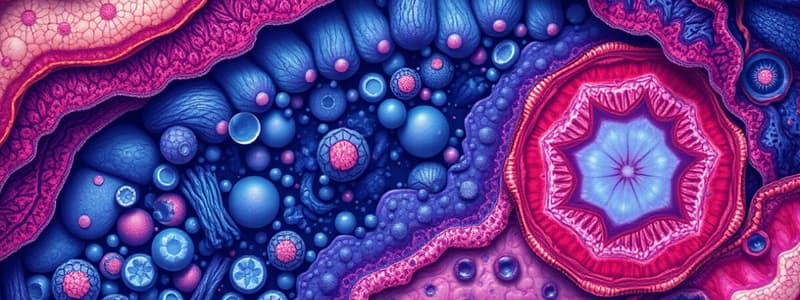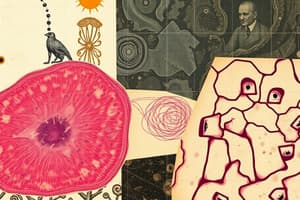Podcast
Questions and Answers
What type of epithelium is primarily found in the outer layers of the skin?
What type of epithelium is primarily found in the outer layers of the skin?
- Columnar
- Pseudostratified ciliated columnar
- Simple squamous
- Stratified squamous (correct)
Which connective tissue cell is responsible for secreting protein fibers and ground substance?
Which connective tissue cell is responsible for secreting protein fibers and ground substance?
- Adipocytes
- Osteocytes
- Chondrocytes
- Fibroblasts (correct)
Which type of connective tissue stores triglycerides?
Which type of connective tissue stores triglycerides?
- Dense connective tissue
- Adipose tissue (correct)
- Reticular connective tissue
- Areolar connective tissue
What is the main protein found in connective tissue?
What is the main protein found in connective tissue?
What type of epithelial tissue is characterized by a single layer of flat cells?
What type of epithelial tissue is characterized by a single layer of flat cells?
Which type of epithelium is commonly found lining blood vessels?
Which type of epithelium is commonly found lining blood vessels?
Which connective tissue type is classified as loose connective tissue?
Which connective tissue type is classified as loose connective tissue?
Which of the following epithelial tissues appears to have multiple layers but is actually a single layer?
Which of the following epithelial tissues appears to have multiple layers but is actually a single layer?
What classification is used to categorize epithelial tissues based on their layers?
What classification is used to categorize epithelial tissues based on their layers?
Which connective tissue is primarily responsible for transporting substances in the body?
Which connective tissue is primarily responsible for transporting substances in the body?
Where is simple cuboidal epithelium primarily found?
Where is simple cuboidal epithelium primarily found?
Which of the following cells is involved in the formation of cartilage?
Which of the following cells is involved in the formation of cartilage?
What is a common function of simple squamous epithelium?
What is a common function of simple squamous epithelium?
Which epithelial tissue type has cells that are taller than they are wide and can be found lining organs like the intestines?
Which epithelial tissue type has cells that are taller than they are wide and can be found lining organs like the intestines?
What type of epithelia is described as having a layer that can stretch, often found in the bladder?
What type of epithelia is described as having a layer that can stretch, often found in the bladder?
What is the shape of cuboidal epithelial cells?
What is the shape of cuboidal epithelial cells?
Which type of epithelial tissue is primarily responsible for absorption and secretion in the intestines?
Which type of epithelial tissue is primarily responsible for absorption and secretion in the intestines?
What is the primary function of ciliated epithelial tissue containing goblet cells?
What is the primary function of ciliated epithelial tissue containing goblet cells?
In which locations can you find transitional epithelium?
In which locations can you find transitional epithelium?
What type of cartilage makes up the malleable part of the external ear?
What type of cartilage makes up the malleable part of the external ear?
What characterizes stratified squamous epithelium?
What characterizes stratified squamous epithelium?
Which type of epithelial tissue is known to have a rare occurrence and consists of column-shaped cells in multiple layers?
Which type of epithelial tissue is known to have a rare occurrence and consists of column-shaped cells in multiple layers?
What happens to the chondrocytes of cartilage as a patient ages?
What happens to the chondrocytes of cartilage as a patient ages?
What is the primary function of the goblet cells found in ciliated tissue?
What is the primary function of the goblet cells found in ciliated tissue?
Which type of muscle tissue is characterized by intercalated discs and branching?
Which type of muscle tissue is characterized by intercalated discs and branching?
Which statement is true regarding skeletal muscle fibers?
Which statement is true regarding skeletal muscle fibers?
How do the cells of transitional epithelium respond when the bladder is full?
How do the cells of transitional epithelium respond when the bladder is full?
What role does the epiglottis play during swallowing?
What role does the epiglottis play during swallowing?
Which of the following is NOT a location for stratified cuboidal epithelium?
Which of the following is NOT a location for stratified cuboidal epithelium?
Which component is NOT a part of the Haversian System in bone tissue?
Which component is NOT a part of the Haversian System in bone tissue?
What type of connective tissue is blood classified as?
What type of connective tissue is blood classified as?
What characteristic is unique to visceral muscle tissue?
What characteristic is unique to visceral muscle tissue?
What is the primary function of the subcutaneous layer of loose connective tissue?
What is the primary function of the subcutaneous layer of loose connective tissue?
What are the characteristics of reticular connective tissue?
What are the characteristics of reticular connective tissue?
What distinguishes dense irregular connective tissue from dense regular connective tissue?
What distinguishes dense irregular connective tissue from dense regular connective tissue?
Which of the following cartilage types is primarily thick and tough?
Which of the following cartilage types is primarily thick and tough?
Which connective tissue is primarily responsible for strength in response to multi-directional forces?
Which connective tissue is primarily responsible for strength in response to multi-directional forces?
What is the primary role of hyaline cartilage?
What is the primary role of hyaline cartilage?
What type of cells are primarily found in elastic connective tissue?
What type of cells are primarily found in elastic connective tissue?
Which process describes the conversion of glycogen into glucose?
Which process describes the conversion of glycogen into glucose?
Flashcards are hidden until you start studying
Study Notes
Animal Tissues Overview
- Animal tissues are classified into four basic types: epithelial, connective, muscle, and nervous tissue.
- Histology is the study of the microscopic anatomy of cells and tissues.
Epithelial Tissues
- Epithelial tissues cover body surfaces, form glands, and line hollow organs, cavities, and ducts.
- Classification is based on layers (simple vs. stratified) and shape (squamous, cuboidal, columnar).
- Shapes of epithelial cells:
- Simple squamous: single layer of flat cells; functions in diffusion (e.g., alveoli in lungs).
- Simple cuboidal: single layer of cube-shaped cells; involved in secretion and absorption (e.g., kidney tubules).
- Simple columnar: taller cells may have microvilli or cilia; functions in absorption and secretion (e.g., digestive tract).
- Pseudostratified columnar: appears stratified, but all cells contact the basement membrane; common in respiratory tract.
- Stratified squamous: multiple layers for protection against abrasion; found in skin.
- Transitional: cells change shape based on tissue stretch; found in urinary bladder.
Connective Tissues
- Connective tissues are the most abundant and widely distributed, classified as either embryonic or mature.
- Key functions include binding tissues, supporting organs, insulating fat, and transporting substances (e.g., blood).
- Main cell types:
- Fibroblasts: secrete proteins and maintain the extracellular matrix.
- Chondrocytes: produce cartilage.
- Osteocytes: form bone tissue.
- Adipocytes: store fat.
Types of Connective Tissues
- Loose Connective Tissue:
- Areolar tissue: widely distributed, provides cushioning.
- Adipose tissue: stores energy and insulates.
- Reticular tissue: forms a supportive framework for organs (e.g., lymph nodes).
- Dense Connective Tissue:
- Dense irregular: collagen fibers arranged in various directions for multidirectional strength (e.g., dermis).
- Dense regular: collagen fibers aligned; found in tendons and ligaments for unidirectional strength.
- Elastic: contains elastin fibers, allows tissue to stretch (e.g., aorta).
- Cartilage:
- Hyaline: smooth surface for joint movement; found in joints, ribs, and respiratory tract.
- Fibrocartilage: tough, supports heavy loads (e.g., intervertebral discs).
- Elastic: flexible cartilage found in structures like the ear and epiglottis.
- Bone:
- Composed of a calcified matrix; osteocytes develop from chondrocytes as maturity increases.
Muscle and Nervous Tissues
- Muscle and nerve tissues are the final two types of the basic tissue group.
- Neurons and muscle fibers are excitable cells that generate electrical signals (action potentials).
- Types of Muscle Tissue:
- Skeletal: striated, multinucleated, voluntary control; nuclei located peripherally.
- Cardiac: striated, single centrally located nucleus, involuntary; contains intercalated discs and branches.
- Smooth (Visceral): non-striated, involuntary; has a single central nucleus and tapered ends.
Summary of Nerve Function
- Action potentials propagate along neuron and muscle membranes due to voltage-gated ion channels, enabling cell communication and contractions.
Studying That Suits You
Use AI to generate personalized quizzes and flashcards to suit your learning preferences.



